Visiting Mandalay in a wheelchair: discovering Buddhism
After a year of Working-Holiday-Visa in New Zealand and three months travelling through south-east Asia it was time to go back home. But before going back to France I was invited by Myanmar Accessible Tourism Center and Mira Travels agency to help them develop accessible travels for disabled people. So here we are in Myanmar during ten days to visit the country, test tourist sites accessibility and think about how to improve it.
First step of our route: Mandalay. Today it is the second biggest city of the country, where a lot of business take place and Chinese people immigrate, but between 1861 and 1885 it was the capital of the Burmese Kingdom.
Sommaire
Mandalay royal palace
So it sounds like a good start to visit the former royal palace in order to understand this royal period. Let’s go stroll through those vestiges of a royal era which ended with the British colonists arrival. Historical buildings were destroyed by bombings during the second world war so those we can see today are replicas made of red wood and covered with golden leaves.
In the fortress we also can see a replica of the lion throne (the original one is in Yangon in the national museum). It is the biggest throne, the one where the King used to sit in the company of his “chief wife”, one of his many wives. Indeed, the King was married to about fifty women and had more than one hundred children. Among those wives only four were very important and got to enjoy their own rooms inside the palace fortress.
Regarding accessibility there are three steps at the entrance but guards can open the front gate in order to avoid them. You just need your guide to ask for it. However, just after that, there are stairs with a dozen steps to reach the lion throne. Once at the top it is easier to take on the left side (when facing the throne) as it is more accessible. (On the right there are two steps and a gap on the floor). The ground is made of damaged concrete or packed gravels. It is not the easiest but it is possible to roll on it. All the buildings are not wheelchair accessible because there is at least one step to enter inside.
Shwenandaw monastery
The site is not fully accessible. There are two steps at the entrance but guards can open the gate to avoid them. From there it is possible to see the outside but unfortunately it is impossible to see the inside without climbing about fifteen steps and step over a plank of wood.
Kuthodaw pagoda
As Myanmar is a predominantly a buddhist country, there are pagodas everywhere, which are places of worship. Mandalay is no exception and we have been amazed by pagodas’ beauty while looking at the Kuthodaw pagoda. Its architecture is very different from French churches and Indonesian and Malaysian mosques. In Myanmar “golden” is the key word! Many pagodas are fully covered by gold! Plus, to our surprise, this pagoda shelters “the world’s largest book”!
Indeed the pagoda is encircled by more than 700 stupas, each one protecting a marble slab. On those slabs are carved the complete teachings of the Buddha. Those texts include three parts: rules to follow as a monk, stories of the many Buddha’s lives and the buddhism philosophy.
Of all the pagodas I visited, this is one of the easiest to go around in a wheelchair. It is possible to be dropped off just in front of the entrance. Then to enter the pagoda there are three steps but this is not an issue as there is a big ramp. After we get through this ramp the main pathway is accessible. To go outside of this main path it is necessary to go through small steps but this should be solved by using a foldable ramp.
Mahamuni pagoda
Mahamuni is an important pilgrimage place for Burmese people. This place shelters a huge Buddha statue of four metres high fully covered by gold. Each buddhist Burmese try to come here at least once during his/her life to meditate and put another golden leaf on the Buddha. Indeed the ultimate goal for a buddhist is to reach the nirvana and one way to get closer to it in the next life is to donate.
There are so many golden leaves that we can see some of them quivering on the Buddha chest and many gold garbages kilos are collected every year at the bottom of the statue. Burmese enthusiasm is almost as impressive as the statue itself!
Regarding accessibility there are two steps at the entrance to access the pathway leading to the temple. This pathway is made of tiles so it is easy to roll on. However there is a step followed by a small gap between each corridor.
Mahaganaryon monastery
Mahaganaryon monastery is one of the most famous in Myanmar due to its strict discipline. I really liked this visit. We learnt a lot about monks way of life, Buddhism philosophy and its impact in a country where almost 90% of the population are buddhists and where every men, from seven years old, can become a monk should it be for a week or several years. The 1200 monks living in this monastery have to follow a training during five to seven years and, in spite of its difficulty, there are many candidates. Only the best, the ones who received two recommendation letters from another monastery, can hope to be trained in Mahaganaryon monastery.
We started by visiting the kitchens where volunteers cook the monk meals using the food donated to them. Indeed monks don’t cook and are not allowed to buy food. In order to collect food they walk in city and villages streets with a black pot in their hands. However they can’t ask for food so they need to wait until someone offer food to them. People can make offerings like that in the streets or they can donate directly to the monastery. In that latter case, they have to make a reservation early, six to twelve months before, as so many people want to do it.
Kitchen are quite basic. Hygiene is relative: men cook most of the time shirtless and bare-footed, dogs and cats hang around and flies set down on food. The cooking is traditional: rice, vegetables, meats are cooked in very big pans or baked in wood-fired ovens.
While waiting for the lunch and the monks procession arrival, we explore the monastery. For some of them, it is shaving time. For others, it is time to collect food. We glimpse young boys wearing white. Our guide tells us that white robes are for pre-novice, too young to start their training, but granted to stay on the monastery premises.
It is now noon. It will be the monks final meal for the day, as they eat only twice a day, at 6am and 12pm. Their arrival follows a formal protocol: monks are aligned in two rows, holding their pot to collect their food and move slowly towards the dinning hall. Outside of this hall we briefly see homeless people waiting for leftovers that monks will be willing to give.
The monastery is really easy to go around in a wheelchair. I was able to go everywhere. Only the dining hall can be observed from closer by people who can climb two steps but we can still see everything from a wheelchair.
U Bein bridge
After so many cultural discoveries it is time to relax and enjoy a stroll on U Bein bridge, the longest teak bridge in the world as it is 1,2 kilometres long. The setting is really nice. On both sides of the bridge men are fishing from their boat or simply by walking in the river with water until their necks. It is the end of September: it is now the end of the rainy season. The river level started to go down but we still can’t see neither the trees trunks nor the ducks farms. For now only their roofs are visible. In a few weeks it will be dry season and the river will only be a memory. The bridge will be entirely out of the water and farmers will be back in their ducks farms.
Regarding accessibility there are two steps at the beginning of the bridge, including a long one. The wooden boards ground is not very wheelchair friendly and quite shaky. The beginning of the bridge is easier to roll on but further away it is getting more difficult.
Discovering local workshops
Mandalay is known to have a lot of local workshops. So while we were here we took some time to visit a longyi (the traditional Burmese clothe) and a golden leaves workshops.
Weaving a longyi is a meticulous work which needs to be done by a patient person. Despite the rapidity of the young Burmese women, it takes one to three months, eight hours a day, to weave a longyi. The result is amazing. I couldn’t resist to buy one!
In the golden leaves workshop work gets more physical. Making those leaves which will cover thousands of pagodas is not an easy work. After many steps, men hit vigorously the gold with a mallet in order to make it thiner. After which women pack the golden leaves carefully in small sachets.
There is one step and one edge at the entrance of the weaving workshop. The shop is not accessible as there are steps at the entrance and it is too narrow inside to roll around easily.
There is one step to enter the golden leaves workshop and another to enter the shop.
Mandalay hill
Mandalay hill is the perfect spot to finish a day in Mandalay. From the top of the hill the landscape is magnificent. Rays of sunlight illuminate vast plains and make many pagodas shine while still hidden in those green fields.
Most of people reach the top of the hill by climbing many stairs. However it is possible to access the top of the hill by car. There are lifts to go at the very top. Unfortunately there are four steps to get to the lift which closes at 6pm. Also the safeguard rail around the hill is quite high so it is more difficult to have a good view from a wheelchair. If you can’t stand on your legs you will have to glimpse between the holes.
Accessibility in Mandalay
- As in many others south-east asian countries we visited, rolling around Mandalay is not easy. Sidewalks rarely have curb-cuts and there is often an obstacle in the way. Consequently it is easier to roll on the side of the road. Also, if you are on a sidewalks be careful as there are holes that are big enough to fall into.
- For lack of a great accessibility, Burmese people are kind and very helpful. They will try to help you in any way they can.
- Regarding the accommodation I stayed at “Hotel Mandalay”. Superior rooms are wheelchair accessible. There are about two centimetres edge to enter the room and then the bathroom but it didn’t bother me. The bathroom is big enough to roll in with a wheelchair and to transfert from side to side from a wheelchair to the toilets. However there is no handrail nor shower seat. The hotel communal areas are wheelchair accessible. There are elevators and the restaurant is accessible also. There are stairs in the main entrance but there is another entrance at the back of the hotel (between the 2 buildings) which is without stairs.
If you would like to have more information about travelling in Myanmar you can read about our discoveries in Yangon and the few days we spent in Bagan.
Did you like this post? Feel free to check out my Patreon page to see how you can support the creation of new ones and be a part of iwheeltravel!
And of course, you can share, like and subscribe, to be aware of the lastest posts.
This post has been sponsored by Myanmar Accessible Tourism Center and Mira Travels agency, as they invited me over. However, opinions expressed here are my own.

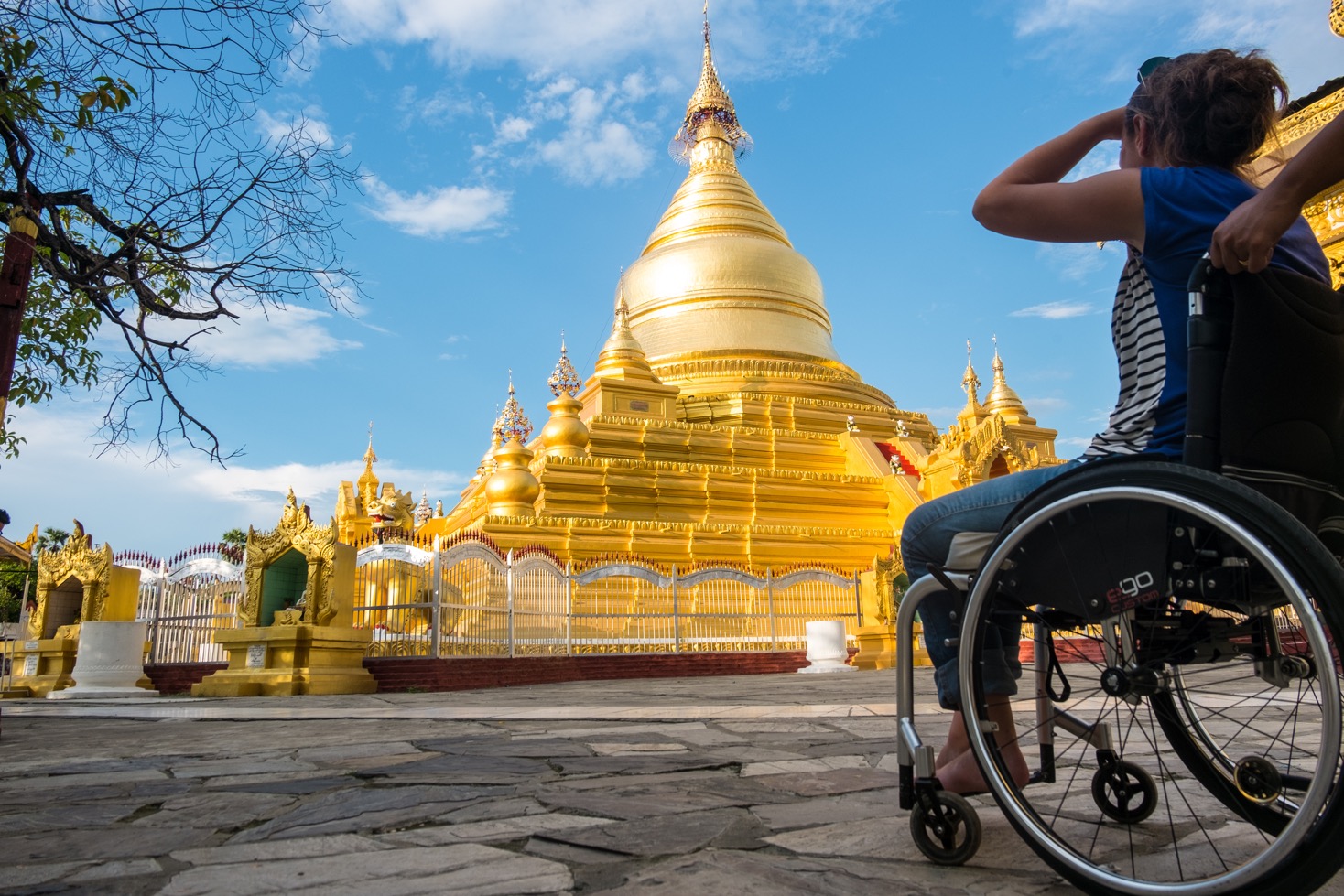
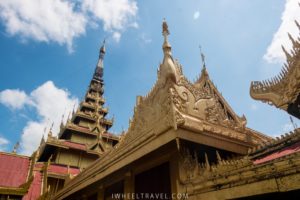
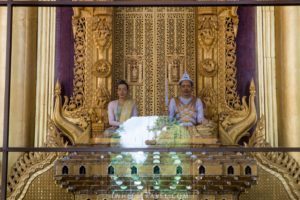
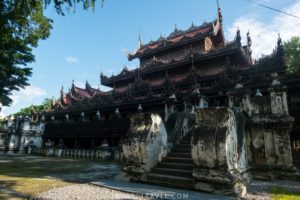
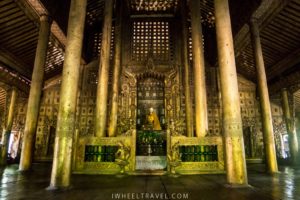
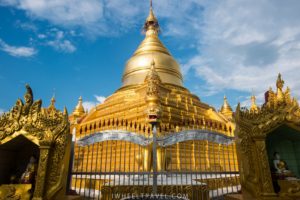
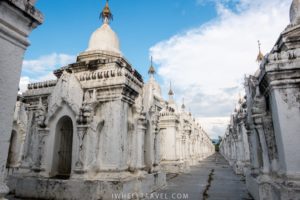
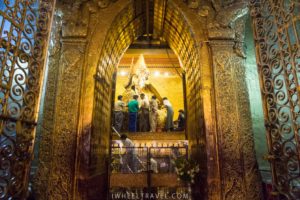
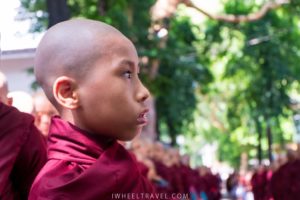
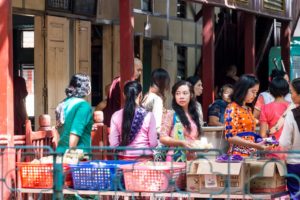
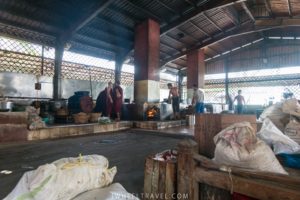
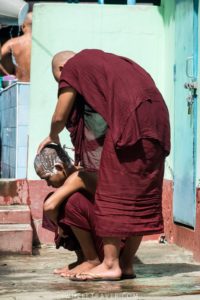
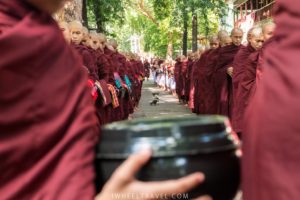
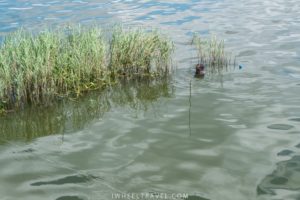
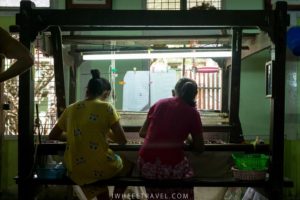
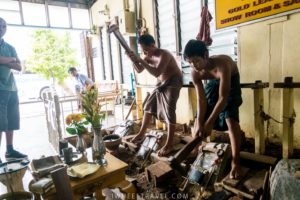
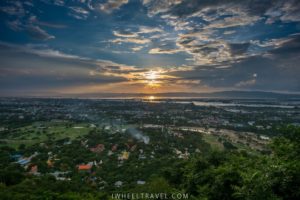
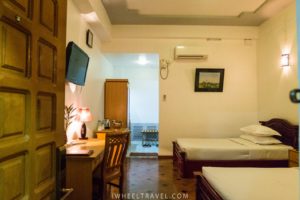





Bertie
Interesting read. Thank you for doing this. Will you later be writing about your experience in Yangon, Bagan, and Ngwe Saung?
Kind Regards
Aurélie
Thank you Bertie. Yes I will write about my other experiences in Myanmar too. Two more posts are coming soon 😉
Bertie
Great!
susie
Fantastic post! I have linked to it on wheelchairworld.org so that other wheelchair using travellers interested in this destination can read your experiences.
Aurélie
I am glad you like it! Thank you for the link on your website. You’re doing a great work listing all those useful information!
Roger
Wonderful site. I’m only just in a wheelchair following a stroke and typed my google search with a degree of pessimism. Lucky I tried it was very useful since I’m going in three days time.
Aurélie
Thank you Roger. I am glad you found the information you needed. How is your Myanmar travel? Is everything going well?